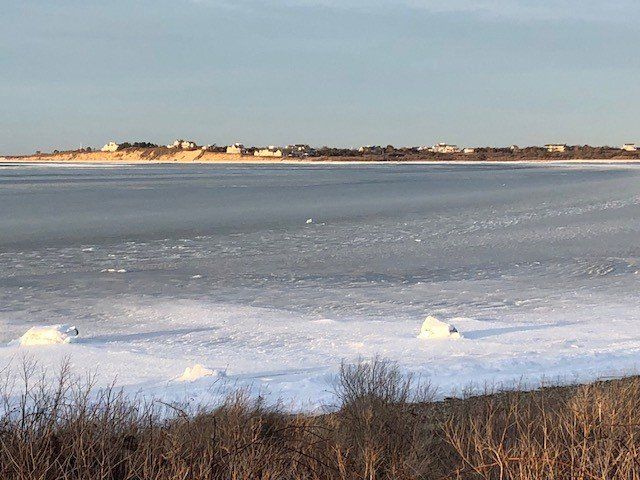What Lies Beneath?
Beneath this frozen beachscape or just adjacent to it in the dunes there may have once been tunnels that led to smuggled goods or perhaps even stashes of gold.
Given climate change and erosion, I’m sure that the dunes were possibly quite a bit further out into where the water is frozen. And, I’m sure this is a delightful legend that was passed on from generation to generation – and quite possibly grew – though most people today I don’t think are aware of it.
This legend has to do with Nantucket’s “she-pirate,” Kezia Folger Coffin (1723 – 1798), a cousin of Benjamin Franklin. She was at least two generations older than Maria – but Maria would have known her story and her descendants. I once included her in an exhibit on Nantucket women (about a dozen years ago – oh, make me feel old) and got some push back for it. Yes, she was nasty, yes she took advantage of her fellow islanders, but she was smart, crafty, creative, and ingenious.
Kezia was an island merchant. She had many real estate investments, had shops, and actively traded and sold goods. She was largely in charge in her family – her husband was not very successful. He had been at sea but seemed to come home to happily let Kezia manage and earn the family’s bread and butter. It was not an unusual position for women on Nantucket – I’ve written about that quite a bit here. With men away with whaling, coastal traders and fishing, with the heavy influence of the Quaker faith that believe in equality, and with the life of a frontier – a theory that I developed and wrote about in my book The Daring Daughters of Nantucket Island – Kezia was joined by many other women in her pursuits on Nantucket – just not maybe in a “not-so-nice-way.”
With the American Revolution, Nantucket tried to do a bit of fence sitting – she had to. With a harbor the only source of bringing goods in and sitting in the middle of an ocean, Nantucket had to play nice to the British and the Americans. Kezia was a loyalist and as such she played to the British. With blockades on the harbor, she began to develop a monopoly with her British “friends.” She began to loan money to people, extend them credits in her shops and on other areas of services she provided. Kezia developed a monopoly over trade on the island and held her fellow islanders captive. She came to have liens on their properties and she became the only place in town to buy needed goods. Kezia and her close male cohorts saw nothing wrong with working with the British in order to secure goods for the island. Kezia in particular would take advantage of her fellow islanders by charging high prices for goods that only she could provide due to her connections.
Finally, Nantucket claimed neutrality – it was forced to stop its fence sitting when it became apparent to the American side what was happening. Kezia was devastated financially – bankrupted. Her properties, goods, everything, were put on the auction block and islanders came to bid – at super low offers in order to punch back at Kezia and what she had done to them.
When her home was repossessed, Kezia was supposedly carried out on her chair when she refused to leave. She and the others (she was the only woman) were charged and tried at Watertown, Massachusetts for smuggling and aiding the British. If they were found guilty, death was the punishment. The charges were finally dropped and Kezia returned to the island with one purpose: to sue the Town and its people for taking away all of her possessions. Her lawyer son-in-law told her that her plan would never succeed but Kezia supposedly said that she did not necessarily want to win. The legend is that her intent was to tie everything up in court and allow it to drag on for as long as possible. One scholar believes she may have been the inventor of the harassing lawsuit.
While an infamous figure, Kezia is a perfect illustration of the strength of character and the independent nature of Nantucket women.
JNLF
Recent Posts





